 Move Face
Move Face
![]()
![]()
![]()
Translate, rotate, or offset one or more selected faces. This Direct Editing tool is especially convenient if you don't have the parametric history of the part, as is often the case with an imported part.
Move face allows you to translate, rotate, or offset one or more selected faces. This direct editing tool is especially convenient if you do not have the parametric history of the part, as is often the case with an imported part. To move a face, select the Move face command on the toolbar, then select the faces to move. Select Offset, Translate, or Rotate. Then, select an End type: Blind or Up to Entity. Next, set the distance to offset or translate. Do this by entering the distance numerically in the dialog, or moving the orange arrow directly in the graphics area. Use the Opposite direction arrow to move the face in the reverse direction.
If Rotate is instead selected, select the rotation Axis and Rotation angle. Keep the Reapply fillet checked to reapply adjacent filleted edges. When done, click the green checkmark to accept the face movement.
- Click
 .
.
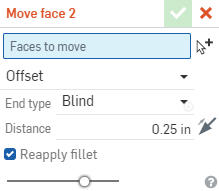
- Select faces to move.
- Select the type of move:
- Offset
- Typically used with non-planar faces to increase or decrease a radius.
- Select any face or combination of faces (Faces field).
- Blind End type - Enter a distance, flip Directional arrow if necessary.
- Up to entity End type - Select a part or surface.
- Specify the value of the offset (Numeric field).
Use the direction arrows to change the direction of the offset, if necessary.
- Translate
- Move one or more faces:
- Select any face or combination of faces (Faces field) to move.
- In the Direction field, select a Mate connector (implicit or explicit) or axis (to define the direction vector parallel to the selected Mate connector), an edge (to define the direction vector parallel to the selected edge), or a face (to define the direction vector normal to the selected face).
- Blind End type - Enter a distance, flip Directional arrow if necessary.
- Up to entity End type - Select a vertex or parallel face.
Optionally use Offset distance to create an offset between faces.
- Rotate
- Rotate one or more faces a specified number of degrees.
- Select any face or combination of faces (Faces field).
- Select the axis or Mate connector (implicit or explicit) to rotate from (Axis field).
- Specify the number of degrees to rotate.
Use the direction arrows to change the direction of the rotation, if necessary.
-
Click
 .
.
The Create Selection (next to the Faces field) can be useful to select related faces for Move face.
This lists the collection of surface feature tools. This is not an exhaustive list. Additional Feature tools may be used when modeling surfaces. See Surfacing for additional information.
-
 Thicken - Add depth to a surface. Create a new part or modify an existing one by giving thickness to a surface and converting it to a solid, adding or removing material from an existing part or surface, or intersecting parts in its path.
Thicken - Add depth to a surface. Create a new part or modify an existing one by giving thickness to a surface and converting it to a solid, adding or removing material from an existing part or surface, or intersecting parts in its path. -
 Enclose - Create a part by selecting all boundaries surrounding an empty space to form a solid. Use any set of surfaces and solids (including planes and faces) that intersect each other or connect at a boundary to create a volume. Create a new part or modify an existing one by adding, removing, or intersecting parts.
Enclose - Create a part by selecting all boundaries surrounding an empty space to form a solid. Use any set of surfaces and solids (including planes and faces) that intersect each other or connect at a boundary to create a volume. Create a new part or modify an existing one by adding, removing, or intersecting parts. -
 Fillet - Round sharp interior and exterior edges and define as a standard constant radius, more stylized conic, or variable by selecting Edge fillet. Optionally apply a Full round fillet to create a seamless blend of one or more faces between two opposing sides.
Fillet - Round sharp interior and exterior edges and define as a standard constant radius, more stylized conic, or variable by selecting Edge fillet. Optionally apply a Full round fillet to create a seamless blend of one or more faces between two opposing sides. -
 Face blend - Round sharp connected or disconnected interior and exterior faces to create a seamless blend between the faces or detach the blend to create new faces, defining a radius or constant width. Further define the blend cross section (rolling ball or swept profile), symmetry, control, trim, constraints, and limits.
Face blend - Round sharp connected or disconnected interior and exterior faces to create a seamless blend between the faces or detach the blend to create new faces, defining a radius or constant width. Further define the blend cross section (rolling ball or swept profile), symmetry, control, trim, constraints, and limits. -
 Delete face - Remove geometry from a part. Select whether to heal the surrounding faces (by extending until they intersect), cap the void, or leave the void open. This Direct Editing tool is especially convenient if you don't have the parametric history of the part, as is often the case with an imported part.
Delete face - Remove geometry from a part. Select whether to heal the surrounding faces (by extending until they intersect), cap the void, or leave the void open. This Direct Editing tool is especially convenient if you don't have the parametric history of the part, as is often the case with an imported part. -
 Move face - Translate, rotate, or offset one or more selected faces. This Direct Editing tool is especially convenient if you don't have the parametric history of the part, as is often the case with an imported part.
Move face - Translate, rotate, or offset one or more selected faces. This Direct Editing tool is especially convenient if you don't have the parametric history of the part, as is often the case with an imported part. -
 Replace face - Trim a face or extend a face to a new surface. This Direct Editing tool is especially convenient if you don't have the parametric history of the part, as is often the case with an imported part.
Replace face - Trim a face or extend a face to a new surface. This Direct Editing tool is especially convenient if you don't have the parametric history of the part, as is often the case with an imported part. -
 Offset surface - Create a new surface by offsetting an existing face, surface, or sketch region. Set offset distance to 0 to create a copy in place.
Offset surface - Create a new surface by offsetting an existing face, surface, or sketch region. Set offset distance to 0 to create a copy in place. -
 Boundary surface - Create or add a surface specified by its boundary profiles.
Boundary surface - Create or add a surface specified by its boundary profiles. -
 Fill - Create a surface (or a part from surfaces) by defining boundaries and refine the surface with boundary conditions (instead of requiring the use of reference surfaces).
Fill - Create a surface (or a part from surfaces) by defining boundaries and refine the surface with boundary conditions (instead of requiring the use of reference surfaces). -
 Move boundary - Move boundary edges of a surface in order to extend or trim it.
Move boundary - Move boundary edges of a surface in order to extend or trim it. -
 Ruled surface - Create a new or additional ruled surface from an existing edge or multiple edges of a sketch region.
Ruled surface - Create a new or additional ruled surface from an existing edge or multiple edges of a sketch region. -
 Mutual trim - Trim two adjacent surfaces by extending intersections to complete the trim.
Mutual trim - Trim two adjacent surfaces by extending intersections to complete the trim. -
 Constrained surface - Create a surface from a selection of points or mesh data within a specified tolerance. Display deviations and optimize for performance or smoothness.
Constrained surface - Create a surface from a selection of points or mesh data within a specified tolerance. Display deviations and optimize for performance or smoothness.
- Tap the Move Face tool icon (
 ).
).
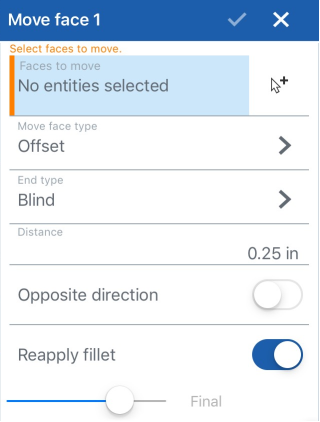
- Select move .
- Select the type of move:
Translate - Move one or more faces in a specified direction for a specified distance
- Select any face or combination of faces to move.
- Select an edge to define a vector.
- Blind End type - Enter a distance, toggle Opposite direction if necessary.
- Up to entity End type - Select a vertex or parallel face.
Rotate - Rotate one or more faces a specified number of degrees
- Select any face or combination of faces.
- Select the axis to rotate from. (Optionally, tap the Mate point connector icon to select or create implicit Mate connectors.)
- Specify the number of degrees to rotate.
Toggle Opposite direction to change the direction of the rotation, if necessary.
Offset - Offset one or more faces a specified distance (typically used with non-planar faces to increase or decrease a radius).
- Select any face or combination of faces.
- Blind End type - Enter a distance, toggle Opposite direction, if necessary.
- Up to entity End type - Select a vertex, edge, or face.
- Specify the value of the offset.
Toggle Opposite direction to change the direction of the offset, if necessary.
- Optionally, toggle to reapply fillet.
- Tap the checkmark.
Move one or more faces in a specified direction for a specified distance.
This shows one face, moved 0.75 inches.
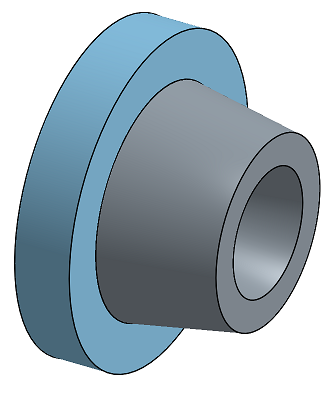
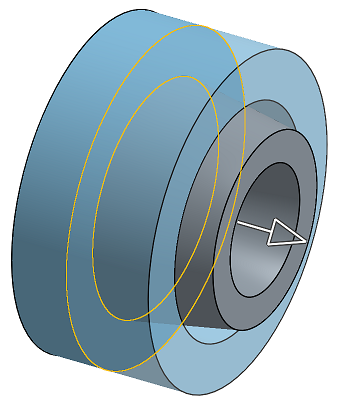
Rotate one or more faces a specified number of degrees
This shows one face rotated 20 degrees.
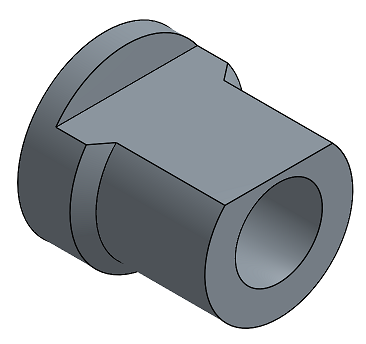
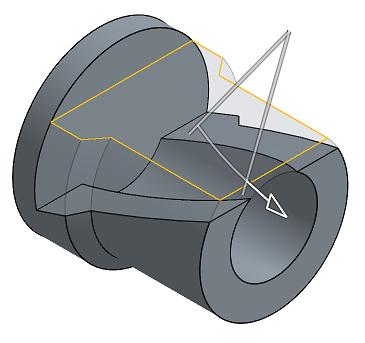
Offset one or more faces a specified distance.
This shows one face, offset by 0.2 inches.
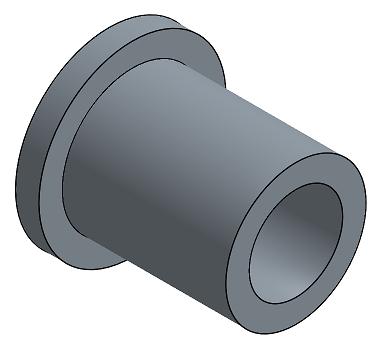
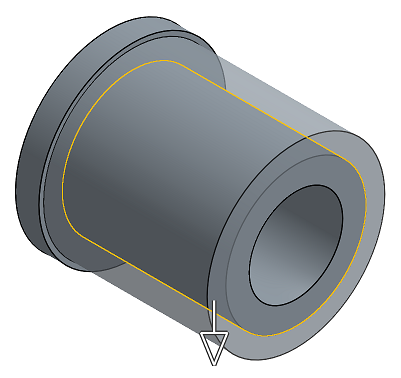
- Tap Move Face tool.

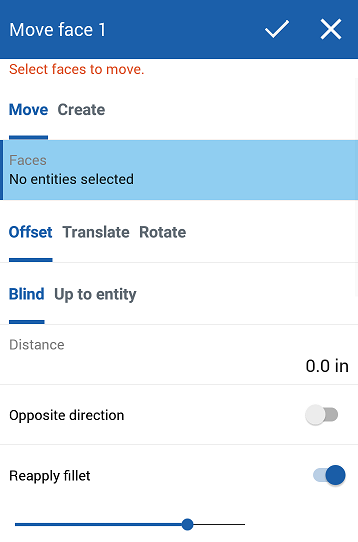
- Select move or create:
- Move - Select faces to move
- Create - Select face and surfaces to reference in order to create a new face
- Select the type of move or create:
Translate - Move one or more faces in a specified direction for a specified distance
- Select any face or combination of faces (Faces field) to move.
- Select an edge to define a vector (Direction field).
- Blind End type - Enter a distance, toggle Opposite direction if necessary.
- Up to entity End type - Select a vertex or parallel face.
Rotate - Rotate one or more faces a specified number of degrees
- Select any face or combination of faces (Faces field).
- Select the axis to rotate from (Axis field).
- Specify the number of degrees to rotate.
Toggle Opposite direction to change the direction of the rotation, if necessary.
Offset - Offset one or more faces a specified distance (typically used with non-planar faces to increase or decrease a radius).
- Select any face or combination of faces (Faces field).
- Blind End type - Enter a distance, toggle Opposite direction, if necessary.
- Up to entity End type - Select a vertex, edge, or face.
- Specify the value of the offset (Numeric field).
Toggle Opposite direction to change the direction of the offset, if necessary.
- Optionally, toggle to reapply fillet.
- Tap the checkmark.
Move one or more faces in a specified direction for a specified distance.
This shows one face, moved 0.75 inches.


Rotate one or more faces a specified number of degrees
This shows one face rotated 20 degrees.


Offset one or more faces a specified distance.
This shows one face, offset by 0.2 inches.

